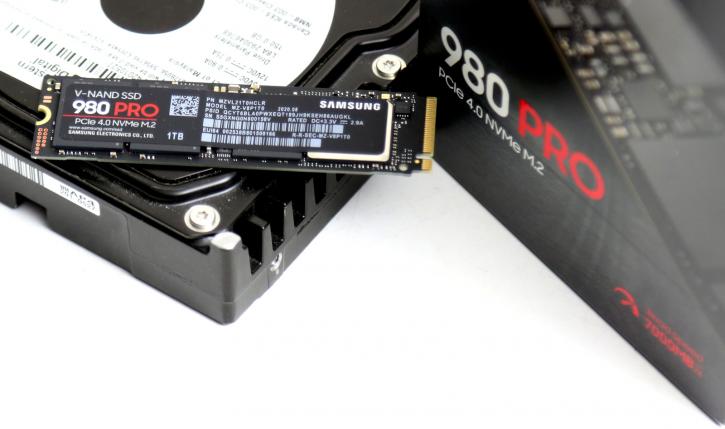Introduction
Samsung 980 PRO NVMe M.2.1TB SSD
Samsung has released its first-ever PCIe Gen 4.0 NVMe SSD, meet the 980 PRO that is advertised at blistering performance running towards 7 GB/sec. Based on 3-bit per cell writes, will Samsung be able to deliver with the all-new 980 PRO series? And do actually you need an SSD this fast? Let's find out.
Samsung today outs its first PCIe 4.0 SSDs dubbed the 980 Pro, and on that PCIe Gen 4.0 link, it achieves read speeds of up to 7 GB/s; there will be three models with a fourth model pending later release (2TB). As mentioned, the connection interface supports PCIe 4.0 x4, and the sequential access speed reaches up to 7,000 MB/s for reading and 5,000 MB/s for writing for the 1 TB model. The 6th generation V-NAND, the latest 3D NAND from Samsung, is be used for NAND flash memory. The number of stacked layers has increased to 128, and not only capacity and access speed but also power efficiency have been improved compared to the previous generation V-NAND. Three models are released, 250GB, 500GB, and 1TB, with a 2TB model scheduled to be released at a later date. While the stability and safety of your data have become a number one priority for the manufacturers, the technology keeps advancing at as fast a pace as it does, the performance numbers a good SATA3 SSD offers these days are simply breathtaking. You get between 450 MB/s to 500 MB/sec on SATA3, which is the norm for a single controller based SSD. Now in the year 2020, by combining advanced NAND Flash controller with PCIe Gen4 x4, NvMe 1.3 interface, and 3D NAND Flash, PCIe M.2 delivers sequential read speed moving to that 7,000 MB/s domain, shocking numbers when you realize that it was only a year or three ago when a 128 GB SSD was hot stuff at 1,000 MB/sec. With the market being so huge, fierce, and competitive, it brought us to where we are today... excellent volume SSDs at acceptable prices with speedy performance. The performance numbers a good SATA3 SSD offers these days are excellent. Still, with the more niche NVMe SSDs you can see sustained performance increase at exponential differences, which offers serious numbers. The unit follows a smaller M.2 2280 form factor (8cm), so it will fit on most ATX motherboards capable of M.2 just fine.
You do need a modern motherboard with a capable NVMe supported M.2 (PCIe 4.0 x4 connected) interface, though, please do check out your motherboard and processor manufacturer for that. Currently, there's just one party to turn towards, and that is AMD with the Series 500 chipset as well as Ryzen 3000 processors. Have a peek, and then let's head onwards into this review.


